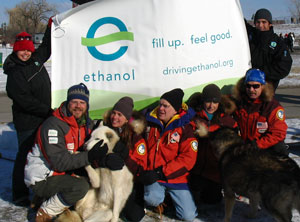Think biodiesel is just for slow-moving tractors? Check out this picture of a motorcycle Greenline Industries will be showcasing at the National Biodiesel Conference & Expo in San Antonio, TX later this week.
Built by Oakland, California-based The Crucible, a non-profit educational collaboration of arts, industry and community, this thing will attempt to break the land-speed record for a diesel-powered motorcycle at the famed Bonneville Salt Flats this coming fall. The record is 105 mph. This thing has already been clocked at 130 mph! This is from a Greenline press release:
“We believe in proving the simple point that diesel fuels are exceptionally efficient in smaller engines, and that biodiesel is the
ultimate form of diesel,” said Ted Lavoie, Greenline’s CEO. “That is why we have sponsored the Earthrace circumnavigation world record attempt, and that is why we are sponsoring The Crucible’s land speed record attempt.”
“We hope to show the world the performance potential of bio-fuels by breaking the existing diesel record and establish records for both biodiesel and SVO at the home of high performance, the Bonneville Salt Flats,” said Michael Sturtz, Die Moto’s rider and The Crucible’s Executive Director.
See it for yourself at the National Biodiesel Conference & Expo February 4th-7th in San Antonio, TX.


 Once again this year I’ll be the biodiesel blogger at the National Biodiesel Conference which kicks off this weekend in San Antonio. I’ll be posting pictures, interviews and video clips during the conference. To get us started I interviewed
Once again this year I’ll be the biodiesel blogger at the National Biodiesel Conference which kicks off this weekend in San Antonio. I’ll be posting pictures, interviews and video clips during the conference. To get us started I interviewed 

 Ethanol power was on display at the recent Big Boy Toy Show in Sioux Fall, SD. From planes to big trucks to race cars, it was all there for both big and little boys (and girls!) to enjoy.
Ethanol power was on display at the recent Big Boy Toy Show in Sioux Fall, SD. From planes to big trucks to race cars, it was all there for both big and little boys (and girls!) to enjoy. Kids of all shapes and sizes enjoyed playing in the car, as well as getting to meet Jeff who posed for pictures and signed autographs.
Kids of all shapes and sizes enjoyed playing in the car, as well as getting to meet Jeff who posed for pictures and signed autographs. Legendary explorer Will Steger kicked off his
Legendary explorer Will Steger kicked off his  Team Ethanol IndyCar® Series driver Jeff Simmons was among those on hand to see the expedition off, since the
Team Ethanol IndyCar® Series driver Jeff Simmons was among those on hand to see the expedition off, since the  Steger also introduced his team members, Abby Fenton, Elizabeth Andre, and John Stetson, as well as documentary filmmaker Jerry Stenger and photographer and webmaster Jim Paulson who will accompany him on the expedition. The team is pictured here with two of the expedition dogs, and the banner is being hoisted by EPIC Communications Director Joanna Schroeder and Simmons. Steger is the one in the middle.
Steger also introduced his team members, Abby Fenton, Elizabeth Andre, and John Stetson, as well as documentary filmmaker Jerry Stenger and photographer and webmaster Jim Paulson who will accompany him on the expedition. The team is pictured here with two of the expedition dogs, and the banner is being hoisted by EPIC Communications Director Joanna Schroeder and Simmons. Steger is the one in the middle. During the 2007 State of the Union address, President Bush made it very clear that ethanol has a vital role to play in our nation’s long term energy independence goals and public education will play a key role in the continued adoption of renewable fuels. This edition of “Fill Up, Feel Good” discusses what consumers can do to help the country be more energy independent. Audio is with President George W. Bush and
During the 2007 State of the Union address, President Bush made it very clear that ethanol has a vital role to play in our nation’s long term energy independence goals and public education will play a key role in the continued adoption of renewable fuels. This edition of “Fill Up, Feel Good” discusses what consumers can do to help the country be more energy independent. Audio is with President George W. Bush and  The
The 
 A senior research scientist from
A senior research scientist from